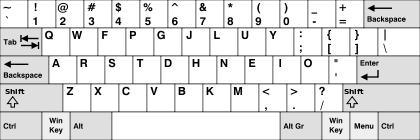Colemak

Colemak is a keyboard layout for Latin-script alphabets, created by and named after Shai Coleman in 2006. The layout is designed to make typing more efficient and comfortable by placing the most frequent letters under the strongest fingers.[1]
Many major modern operating systems such Mac OS, Linux, Android, Chrome OS, and BSD support the Colemak layout by default. A program to install the layout is available for Microsoft Windows.[2]
Overview
The Colemak layout was designed with the QWERTY layout as a base, changing the positions of 17 keys while retaining the QWERTY positions of most non-alphabetic characters and many popular keyboard shortcuts, supposedly making it easier to learn than Dvorak layout for people who already type in QWERTY without losing efficiency. It shares several design goals with the Dvorak layout, such as minimizing finger path distance and making heavy use of the home row.[3] 74% of typing is done on the home row compared to 70% for Dvorak and 32% for QWERTY.[4] The Colemak layout lacks a Caps Lock key; an additional Backspace key occupies the position typically occupied by Caps Lock on modern keyboards.[1]
Coleman states that he designed Colemak to be easy to learn, explaining that Dvorak is hard for QWERTY typists to learn due to it being so different from the QWERTY layout.[5] The layout has attracted media attention as an alternative to Dvorak for improving typing speed and comfort with an alternate keyboard layout.[4][6][7]
Variants
A series of intermediate layouts known as 'Tarmak' have been created with the intention of making it easier for new users to adopt the layout. The layouts change only 3-5 keys at a time in a series of 5 steps.[8]
Colemak has been criticised for placing too much emphasis on the middle-row centre-column keys (D and H), leading to awkward lateral hand movements for certain common English bigrams such as HE.[9] The Colemak user community developed a modified version of Colemak, called Colemak Mod-DH, to address these concerns.[10]
References
- 1 2 "Colemak keyboard layout". Retrieved 2011-08-29.
- ↑ "Colemak keyboard layout". Colemak. Retrieved 2013-02-23.
ergonomic, fast and easy to learn QWERTY/Dvorak alternative
- ↑ Krzywinski, Martin. "Colemak — Popular Alternative". Carpalx keyboard layout optimizer. Canada: Michael Smith Genome Sciences Centre. Retrieved 2010-02-04.
- 1 2 Dunn, Matthew (2017-11-30). "Why you should ditch the QWERTY keyboard layout for one of two other options". news.com.au. Retrieved 2018-02-09.
- ↑ Coleman, Shai. "What's wrong with the Dvorak layout". Retrieved 2018-02-02.
- ↑ Klosowski, Thorin (2013-10-18). "Should I Use an Alternative Keyboard Layout Like Dvorak?". Lifehacker. Retrieved 2018-02-09.
- ↑ Zukerman, Erez (2012-06-08). "How I Quickly Mastered A Superior Keyboard Layout Without Losing Productivity". Makeuseof. Retrieved 2018-02-09.
- ↑ "Learn Colemak in steps with the Tarmak layouts!". Colemak forum. Retrieved 2017-06-01.
- ↑ "Workman Layout - The problem with Colemak".
- ↑ "Colemak Mod-DH".